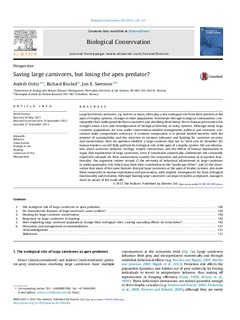| dc.contributor.author | Ordiz Fernandez, Andres Avelino | |
| dc.contributor.author | Bischof, Richard | |
| dc.contributor.author | Swenson, Jon | |
| dc.date.accessioned | 2018-04-04T11:46:51Z | |
| dc.date.available | 2018-04-04T11:46:51Z | |
| dc.date.created | 2014-01-08T10:28:58Z | |
| dc.date.issued | 2013 | |
| dc.identifier.citation | Biological Conservation. 2013, 168 128-133. | nb_NO |
| dc.identifier.issn | 0006-3207 | |
| dc.identifier.uri | http://hdl.handle.net/11250/2492589 | |
| dc.description.abstract | Large terrestrial carnivores, e.g. wolves or bears, often play a key ecological role from their position at the apex of trophic systems. Changes to their populations reverberate through ecological communities; consequently their widespread decline in numbers and shrinking distribution due to human persecution has brought about a loss and reconfiguration of biological diversity in many systems. Although many large carnivore populations are now under conservation-minded management, political and economic constraints make compromises necessary. A common compromise is to permit limited harvests, with the premise of sustainability and the objective to increase tolerance and funding for carnivore recovery and conservation. Here we question whether a large carnivore that has to ‘‘look over its shoulder’’ for human hunters can still fully perform its ecological role at the apex of a trophic system. We use information about carnivore behavior, ecology, trophic interactions, and the effects of human exploitation to argue that exploitation of large carnivores, even if sustainable numerically, undermines the commonly expressed rationale for their conservation, namely the restoration and preservation of ecosystem functionality. Our argument centers around (i) the necessity of behavioral adjustments in large carnivores to anthropomorphic risk, which may limit their contribution to the ‘‘landscape of fear’’, and (ii) the observation that many of the same features that put large carnivores at the apex of trophic systems also make them vulnerable to human exploitation and persecution, with implicit consequences for their ecological functionality and evolution. Although hunting large carnivores can improve public acceptance, managers must be aware of the trade-offs. Behavior Conservation Ecological role Hunting Landscape of fear Management | |
| dc.language.iso | eng | nb_NO |
| dc.rights | Attribution-NonCommercial-NoDerivatives 4.0 Internasjonal | * |
| dc.rights.uri | http://creativecommons.org/licenses/by-nc-nd/4.0/deed.no | * |
| dc.title | Saving large carnivores, but losing the apex predator? | nb_NO |
| dc.type | Journal article | nb_NO |
| dc.type | Peer reviewed | nb_NO |
| dc.description.version | acceptedVersion | |
| dc.description.version | publishedVersion | |
| dc.source.pagenumber | 128-133 | nb_NO |
| dc.source.volume | 168 | nb_NO |
| dc.source.journal | Biological Conservation | nb_NO |
| dc.identifier.doi | 10.1016/j.biocon.2013.09.024 | |
| dc.identifier.cristin | 1085642 | |
| dc.relation.project | Norges forskningsråd: 204202 | nb_NO |
| dc.relation.project | Andre: Direktoratet for naturforvaltning | nb_NO |
| dc.relation.project | Norges forskningsråd: 211300 | nb_NO |
| cristin.unitcode | 192,14,0,0 | |
| cristin.unitname | Miljøvitenskap og naturforvaltning | |
| cristin.ispublished | true | |
| cristin.fulltext | postprint | |
| cristin.fulltext | original | |
| cristin.qualitycode | 1 | |

